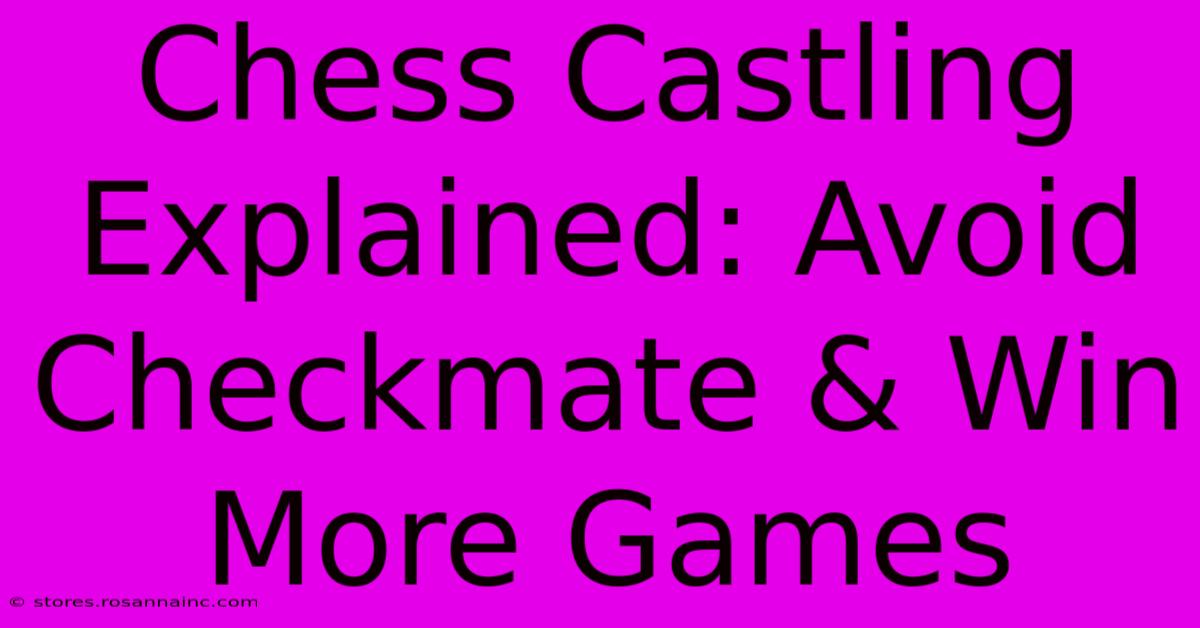Chess Castling Explained: Avoid Checkmate & Win More Games

Table of Contents
Chess Castling Explained: Avoid Checkmate & Win More Games
Castling. A seemingly simple move in chess, yet mastering it can significantly impact your game, offering crucial protection for your king and preparing for a strong offensive. This guide will break down castling, explaining its rules, benefits, and how to effectively use it to avoid checkmate and win more games.
Understanding the Mechanics of Castling
Castling is a special move involving your king and one of your rooks. It's not just moving two pieces individually; it's a single, combined maneuver that offers significant strategic advantages. Here's the breakdown:
-
The Move: You move your king two squares towards a rook, and then place that rook on the square adjacent to the king, jumping over it.
-
Requirements: Several conditions must be met before you can castle:
- Neither piece has moved: Both the king and the chosen rook must be on their original starting squares and have not yet moved during the game.
- No pieces between: There must be no pieces between the king and the rook.
- King not in check: Your king cannot be in check before, during, or after the castling move.
- King doesn't pass through check: The king cannot move through a square that is under attack (check) by an opponent's piece.
- King does not end in check: The king cannot end up in a square that is under attack after castling.
The Benefits of Castling
Why is castling such a valuable move? Here are some key advantages:
-
King Safety: Moving your king to a more secure location, typically behind a pawn shield, significantly reduces its vulnerability to attacks. This is especially important in the opening and middlegame.
-
Rook Activation: Castling brings your rook into the game, positioning it for active participation in attacks and defense. A centrally positioned rook is far more effective than one sitting idly on the back rank.
-
Improved Kingside Defense: Castling usually brings your king to the kingside, which is often better defended by your pawn structure. This adds another layer of protection.
-
Enhanced Control of the Center: While not a direct result, castling often indirectly improves your control over the center of the board, allowing for more coordinated attacks.
Kingside vs. Queenside Castling
While both are valid, most players prefer kingside castling (moving the king to the g-file). This is generally considered safer due to the usual pawn structure on the kingside, and it often leads to more rapid development of your pieces. Queenside castling, while possible, is less common and usually only employed in specific openings or strategic situations where it's tactically advantageous.
When NOT to Castle
While castling is generally a good move, there are situations where it might not be the best option:
-
Your King is already safe: If your king is well-protected by your pieces and pawn structure, and castling would not provide significant additional safety, it might be unnecessary.
-
Your opponent's attack is too strong: If your opponent already has a significant attack directed at your king, castling might not provide sufficient protection. In such cases, you might need to consider alternative defensive measures.
-
Your pawn structure is weak on the kingside: If your kingside pawn structure is severely weakened, castling could expose your king to further attack.
-
Specific openings: Some chess openings deliberately avoid early castling to pursue specific strategic plans.
Mastering Castling: Tips and Strategies
-
Castle early: Generally, it's best to castle in the opening or early middlegame to ensure your king's safety.
-
Coordinate your castling with piece development: Don't castle without first developing your knights and bishops.
-
Consider your opponent's plans: Anticipate your opponent's attacks and choose a castling strategy that is consistent with your defensive plan.
-
Practice: The best way to master castling is to practice. Play games and experiment to understand its nuances in different situations.
By understanding the rules and benefits of castling, and knowing when to employ it and when not to, you can significantly improve your chess game, improving your king's safety and opening up tactical possibilities. Mastering castling is a crucial step towards avoiding checkmate and increasing your chances of victory.

Thank you for visiting our website wich cover about Chess Castling Explained: Avoid Checkmate & Win More Games. We hope the information provided has been useful to you. Feel free to contact us if you have any questions or need further assistance. See you next time and dont miss to bookmark.
Featured Posts
-
Dismantling Ching Chong Building A More Inclusive Future
Feb 10, 2025
-
The Future Of Football Palestines Emerging Talent
Feb 10, 2025
-
From Mississippi Masala To And Just Like That Sarita Choudhurys Stellar Career
Feb 10, 2025
-
Super Bowl Lix Hurts Unbannable Air
Feb 10, 2025
-
Tatum Explodes Celtics Top Knicks Again
Feb 10, 2025
